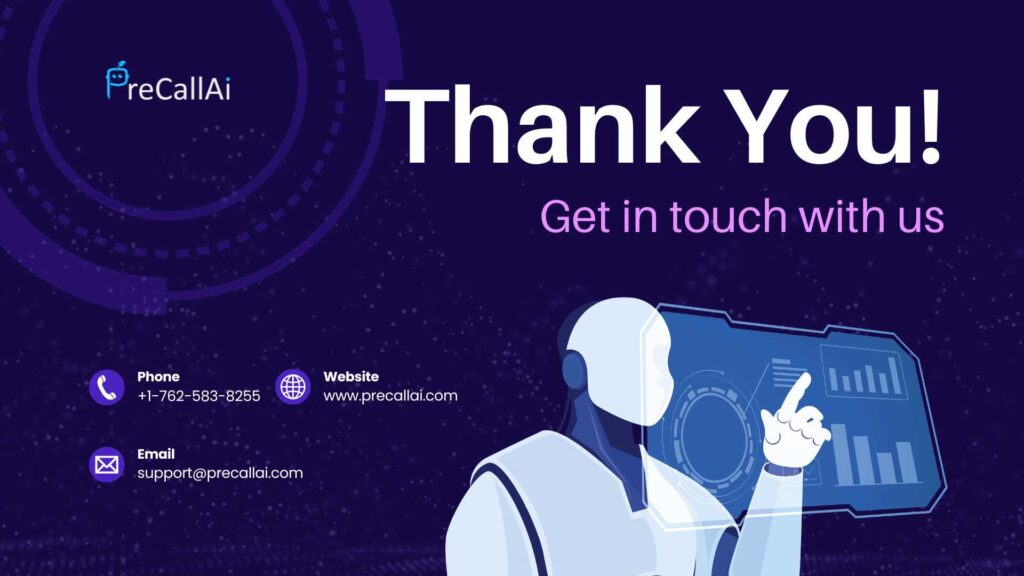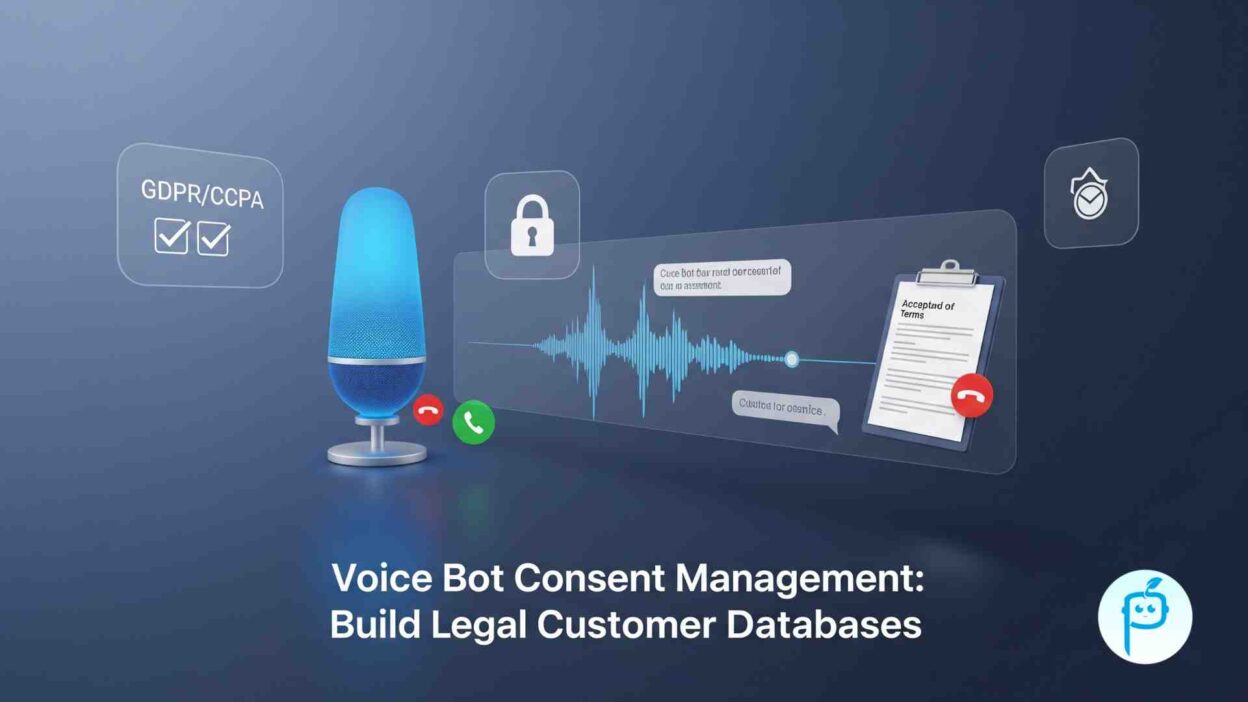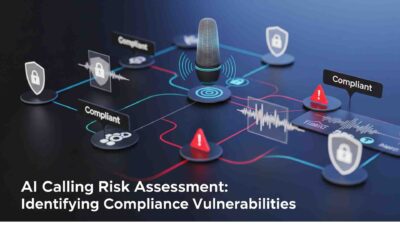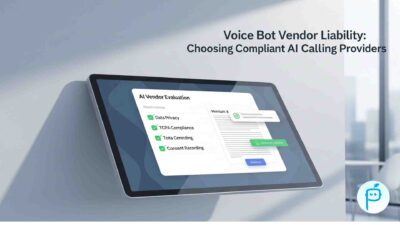Voice bot consent management forms the backbone of successful AI calling campaigns. Modern businesses deploy voice bots to reach thousands of customers daily. Legal compliance safeguards your business against substantial fines and penalties. Smart consent management builds trust with your customer base.
Table of Contents
The Legal Foundation of Voice Bot Consent Management
Regulatory authorities worldwide demand explicit consent for automated calls. TCPA in the United States requires written consent for robocalls. GDPR in Europe mandates clear opt-in mechanisms. India’s TRAI regulations prohibit unsolicited commercial communications.
Voice bot consent management systems track every customer interaction. Digital records prove compliance during audits. Automated systems prevent calls to customers who opted out. Legal databases protect your business reputation.
Understanding AI Calling Permissions Requirements
AI calling permissions vary by region and industry. Financial services face stricter regulations than retail businesses. Healthcare providers must follow HIPAA guidelines. Educational institutions need FERPA compliance.
Express consent beats implied consent in legal disputes. Written agreements provide stronger protection than verbal permissions. Time-stamped records document when customers agreed to calls. Digital signatures create legally binding consent agreements.
Building Compliant Customer Databases
Database architecture determines compliance success. Separate consent tables track permissions by communication channel. Phone consent differs from email marketing permissions. SMS consent requires different opt-in mechanisms.
Customer data hygiene prevents compliance violations. Regular database cleaning removes outdated records. Automated processes update consent status changes. Integration systems sync permissions across platforms.
Voice Bot Consent Management Best Practices
Double opt-in systems verify customer intent. Confirmation calls ensure customers understand agreement terms. Clear language explains how voice bots will contact customers. Specific use cases prevent consent scope creep.
Granular permissions allow selective communication preferences. Customers choose voice bot topics they want to hear. Frequency controls let customers set call limits. Channel preferences respect customer communication styles.
Technical Implementation Strategies
API integrations connect consent systems with calling platforms. Real-time permission checks prevent unauthorized calls. Webhook notifications update consent changes instantly. Database triggers log all permission modifications.
Voice bot consent management requires robust security measures. Encryption protects sensitive customer data. Access controls limit who can modify permissions. Audit trails track all system changes.
Consent Collection Methods
Web forms capture initial customer agreements. Landing pages explain voice bot benefits clearly. Popup modals request specific AI calling permissions. Progressive profiling builds detailed consent profiles.
Phone-based consent collection uses IVR systems. Voice recordings document customer agreements. Automated confirmation emails verify phone consent. SMS confirmations provide written proof.
Managing Consent Lifecycles
Consent expires based on regulatory requirements. Automated reminders request permission renewals. Grace periods prevent immediate communication cutoffs. Re-engagement campaigns win back lapsed customers.
Opt-out mechanisms must be simple and immediate. Voice commands during calls allow instant unsubscribing. Text messages provide easy opt-out options. Website portals let customers manage all preferences.
Data Retention and Deletion
Retention policies define how long to keep consent records. Legal requirements mandate minimum storage periods. Automated deletion removes expired consent data. Archive systems preserve records for audit purposes.
Right to erasure requests require complete data removal. Customer service teams handle deletion requests promptly. Technical systems verify complete data removal. Documentation proves compliance with erasure requests.
Voice Bot Consent Management Technology Stack
CRM systems store customer consent preferences centrally. Marketing automation platforms respect permission settings. Voice bot platforms check consent before dialing. Analytics tools track consent conversion rates.
Cloud-based solutions offer scalability and reliability. On-premise systems provide data control benefits. Hybrid approaches balance security and flexibility. API-first architectures enable easy integrations.
Compliance Monitoring and Reporting
Real-time dashboards show consent status across customer base. Automated alerts flag potential compliance violations. Regular reports demonstrate regulatory adherence. Exception reports identify consent gaps.
Performance metrics track consent collection effectiveness. Conversion rates measure opt-in success. Retention rates show consent durability. Compliance scores indicate regulatory risk levels.
Industry-Specific Considerations
Healthcare voice bots need HIPAA-compliant consent systems. Financial services require additional identity verification. E-commerce platforms integrate consent with purchase flows. SaaS companies embed permissions in onboarding processes.
B2B consent management differs from consumer approaches. Business contacts have different legal protections. Corporate policies may restrict automated communications. Decision-maker consent may require multiple approvals.
International Compliance Challenges
Multi-country operations face complex regulatory landscapes. Data residency requirements affect system architecture. Cross-border data transfers need special protections. Local consent standards vary significantly.
GDPR affects any company serving European customers. CCPA impacts California resident communications. PIPEDA governs Canadian customer data. Local regulations create compliance complexity.
Future Trends in AI Calling Permissions
Blockchain technology promises immutable consent records. Smart contracts could automate permission management. Decentralized systems may give customers more control. Zero-knowledge proofs might enhance privacy protection.
Voice AI advances will require updated consent frameworks. Deepfake detection protects against fraudulent permissions. Biometric verification could strengthen consent collection. Machine learning improves consent prediction accuracy.
Building Customer Trust Through Transparency
Clear privacy policies explain voice bot data usage. Consent forms use plain language customers understand. Regular communications update customers on policy changes. Customer service teams handle consent questions promptly.
Trust badges display regulatory compliance status. Third-party audits verify consent management practices. Industry certifications demonstrate commitment to compliance. Transparency reports show consent management statistics.
Measuring Success and ROI
Consent-based calling campaigns show higher engagement rates. Compliant databases reduce legal risk exposure. Customer satisfaction improves with proper consent management. Long-term customer value increases through trust building.
Cost savings emerge from avoiding regulatory fines. Automated consent systems reduce manual compliance work. Efficient databases improve voice bot campaign performance. Legal protection provides invaluable business insurance.
Voice bot consent management transforms from compliance burden to competitive advantage. Proper implementation protects your business while respecting customer preferences. Investment in consent systems pays dividends through improved customer relationships and reduced legal risks.
Read More: Best Practices For Customer Satisfaction With Voice Bots
Conclusion

Start with a comprehensive audit of current consent practices. Identify gaps between current systems and regulatory requirements. Develop implementation timelines for consent upgrades. Train teams on new consent management procedures.
Select technology partners with a proven track record of compliance. Implement consent systems gradually to minimize disruption. Test all consent flows before full deployment. Monitor performance metrics to ensure system effectiveness.
Voice bot consent management success requires ongoing attention and refinement. Regular reviews ensure continued compliance as regulations evolve. Customer feedback helps improve consent collection processes. Continuous improvement maintains competitive advantages in the evolving voice bot landscape.






[…] members need proper training for voice analytics tools. Customer insights become actionable through proper interpretation. Teams learn to respond appropriately to […]
[…] Voice bot setup eliminates receptionist salary costs completely. Average receptionist salary ranges $25,000-$35,000 annually plus benefits. AI systems cost fraction of human staff expenses long-term. […]